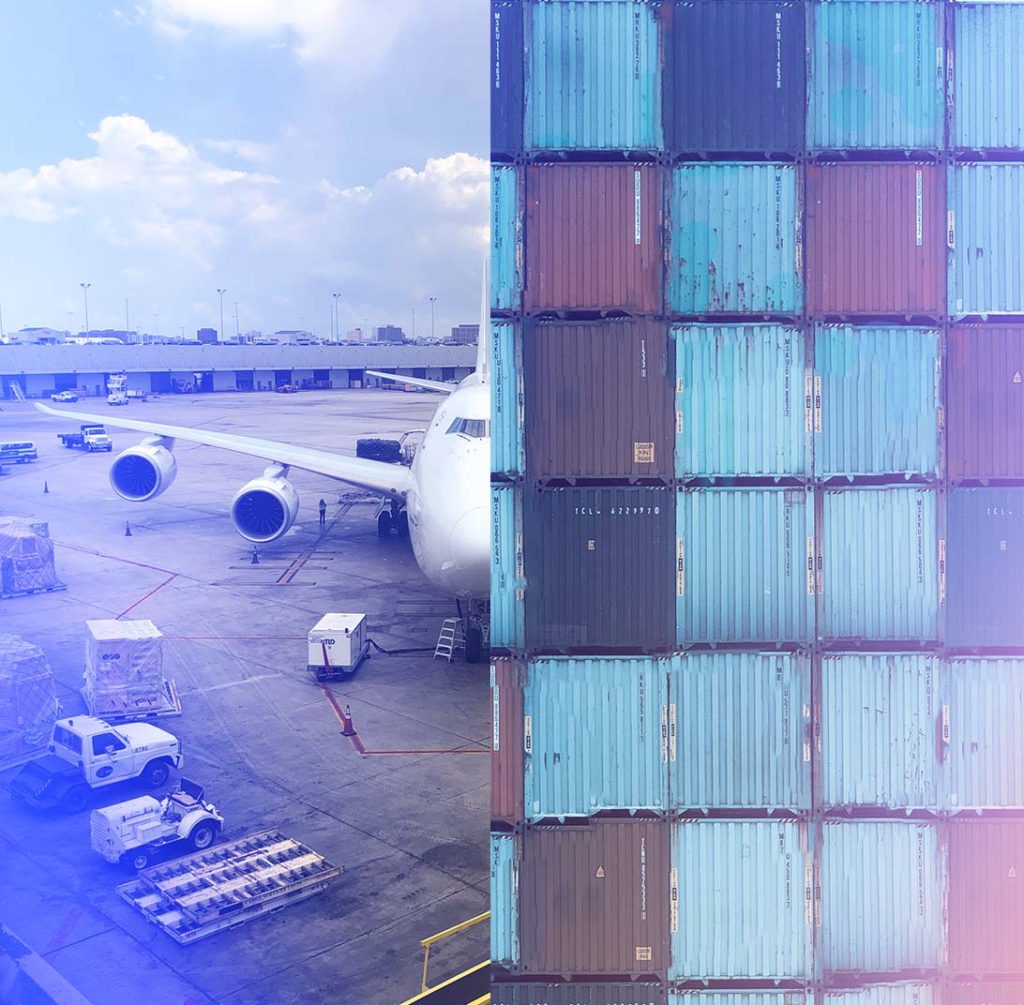Air freight vs Ocean shipping. What advantages to consider ?
We make decisions every day. If you need international freight shipping for your business, you may wonder: what is the best way to transport your goods? What are the advantages of Air freight vs. Ocean shipping?
Sometimes this choice is straightforward. However, when your shipping needs have to meet tight timelines, the answer may become more challenging.
Air and Ocean shipping are the two most popular methods to ship goods across continents. They both have advantages to consider before choosing one or the other. What is the difference between sea freight and air freight?
Clients should always have these factors in mind; distance, type of cargo, time sensitivity, cost consideration, cargo safety, accessibility, and the ecological impact.
Shipping air or ocean freight
Our guide will help you understand the pros and cons of each and determine the ideal mode of transportation for your freight.
Freight characteristics are the base of cost.
Costs are a critical business concern. Entrepreneurs tend to take steps to ensure that their shipping costs are as low as possible to keep a high margin. The Business idea will have to incorporate the transport budget. It will have an impact on whether they choose an ocean liner or a flight.
We have the stereotype that ocean shipping always seems to be cheaper than air freight. However, you need to understand the billing for each shipping mode.
Air freight billing
The chargeable weight is the base of calculation for the air freight costs. You calculate the metric by combining the weight and size (volume) of the shipment.
Ocean freight billing
For ocean shipping, the shipment weight is not the factor of calculation. Instead, for ocean shipping, the billing method is by the container. You pay a flat rate for A full standard container (20 feet X 40 feet). If you decide to ship less than container loads (LCL), you will pay by cubic meter.
For heavy or large shipments, shipping via ocean is often less expensive. But as shipment sizes decrease, the margin between air and ocean prices also decreases.
But the actual cost of transportation is only the beginning. You need to calculate inventory costs and warehousing fees. Also, keep in mind that both modes of transportation will face customs and destination fees when shipping internationally. Those that are using ocean liners need to consider the costs of the warehousing fees. They are due at the seaport. These fees can go over anything that the airport will charge. You can always use fretcot online tool to check air freight or sea freight costs comparison. Check also our tips on how to save on shipping.
Speed varies by shipping mode.
Air freight is faster than ocean shipping. Ocean shipments can sometimes take weeks to arrive. Air freight can reach its destination in only a day or two. Ocean shipping is also getting faster because it optimizes its ocean shipping routes. Ocean shipping is still no beating the speed of air freight.
NOW is the expectation
Faster delivery times are quickly becoming expectations across many industries. But before shipping everything by air, take the time to plan your shipping strategy. It will create long-term efficiencies and save you money.
Shipping distances
The shipping distance is also a factor to take into consideration. Air freight is the most preferred shipping method when it comes to direct city to city transport or direct routes between countries. Sea freight may need to travel great distances with more stops on the way, which allows for the possibility of Less than a container load shipping.
Small ocean shipments that do not fill a full container are consolidated and shipped as LCL; Less than a container load. It takes much longer to ship than full container (FCL) shipments. Customers who want smaller quantities reasonably soon have to pay a premium to go with air freight service.
Expedited LCL Vs. Consolidated Air freight
We see an increase in new fast ocean LCL services. It can compete with air freight for time. It is cheap because: the ships are fast, canal upgrades are cutting delays on some routes. Ocean tracking is more efficient. The freight market is competitive. It is also called Expedited LCL, with guaranteed delivery days, actually faster than FCL, and close to matching air transit times. Air cargo is sometimes put together in a consolidation. It may take some time to consolidate. This service is shipped once or twice a week. So, transit times are usually 6-7 days. Compare this with some express LCL shipments. For instance, the East Coast to Europe can take as little as 10 days.
Both shipping modes are reliable
Delays can affect both modes of transportation for various range of reasons; Bad weather conditions, strikes, traffic congestions, documentation difficulties at customs clearance.
Airlines are typically better at handling schedule changes than ocean carriers. Factors like weather conditions can delay airline schedules more easily than ocean journeys. But flights tend to be rearranged and rescheduled quickly and efficiently. Additionally, there are usually multiple flights each day between major cities, while ships tend to leave weekly.
It does not necessarily mean that air freight is always more reliable than ocean freight. When ships are behind schedule, they tend to need a few days to get back on top of their operations. However, ongoing alliances between ocean carriers can build reliability and integrity for ocean service. It can make ocean shipping an appealing option—even for some time-sensitive freight like perishables, fashion, and auto parts.
All aspects taken together; air freight is often more reliable than sea freight. Whether the best choice is sea or air depends on the risk profile of the product. A total cost analysis could indicate if it is worth the risk of transporting the products by sea.
Type of Cargo
Air service is particularly useful when you are shipping short lives items: fresh food, flowers, or pharmaceutical, high value or time-sensitive products where quick turnover is key (Retail, electronics, phones, computers), or Just in time framework products (machinery, aircraft parts, ship parts, auto or computer parts, etc.). Transportation via air is usually the right choice for products that need to heighten security against pilferage (most warehouses are using CCTV systems).
Air freight has stricter restrictions for hazardous material, packaging, and maximum weight restrictions. It may vary by national laws and airline regulations.
There are some exceptions. For example, bananas are usually shipped by boat due to their long ripening process.
Airfreight is, in most cases, limited by capacity, weight, and safety factors. It reduces the types of cargo it can carry.
Sea freight shipping has an absolute advantage in this case because the container sizes can support any types of goods. Sea freight transports Heavy equipment when air freight cannot accommodate them.
Environmental impact of shipping
It is becoming increasingly important to apply Eco-friendly practices to reduce carbon footprint.
Sea freight is by some regarded as an environmentally friendly choice than air freight. In reality, the truth might be just the opposite. Sea freight can be dirty. The new Sulphur regulations, IMO 2020, that came into effect on January 1st, 2020 is a piece of evidence. It forced the marine sector to reduce Sulphur emissions by over 80%.
Even smaller businesses are considering how they contribute to a more sustainable future. Not having green credentials may have a business impact and results in losing customers. Check how to ship eco friendly?
Should you use air freight or ocean shipping?
Typically, the number one reason to choose air service is the speed of delivery. Number two is the higher security level. Shipping via ocean will be cost-efficient in general for heavy and bulky shipments.
Air transportation for small shipments often makes a lot of sense. It may cost more. For example, an 100 kg shipment might cost $400 by LCL and $600 by air, but your goods will arrive within days rather than weeks. For goods such as retail, where quick turnover is the key, or electronics, which benefits from air freight’s heightened security, air is usually the right choice.
More and more customers are expecting an “Amazon-Esque” experience. They want their products as fast as possible. Delays can cost you money as well as business relationships with your customers. However, the price for faster service is often higher and may increase the cost of your product at the destination. It’s up to you to determine what makes sense to grow your business for your shipping strategy.
So, which should you choose? Evaluate when your goods need to arrive at their destination, what your budget is, and how each mode will affect your business’s top needs.
If shipments have an approaching arrival deadline and your budget allows, ship via air. When the arrival date is more flexible, or you want to save money, ship via ocean.
If you are basing your logistics only on Air freight, keep in mind that ocean freight rates are very stable when Air freight rates are very volatile.
Final Thoughts
If you are having trouble making optimal shipping decisions, you can try www.fretcot.com. The plate-form offers; an easy no sign-up, an online shipping calculator. You can choose your transportation mode based on your budget. Our online tool allows you to compare Air & Ocean international shipping costs at the same time. The freight shipping quote also includes an estimated transit time for each service; Expedited, Air freight, and Ocean transportation. The plate-form provides impressive online freight services through their online portal. You can easily Quote, Book, ship, and track a shipment.[/brando_feature_box]





